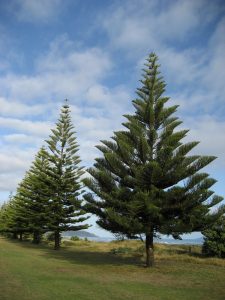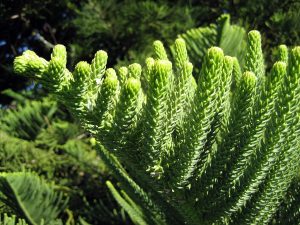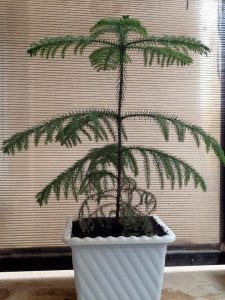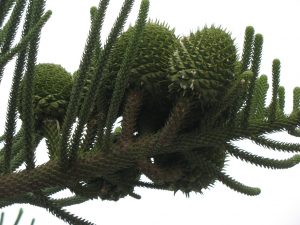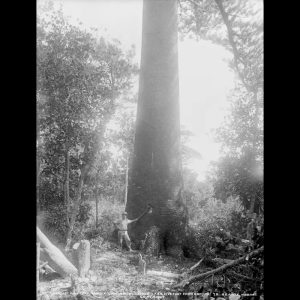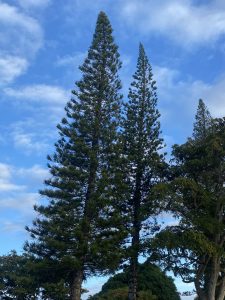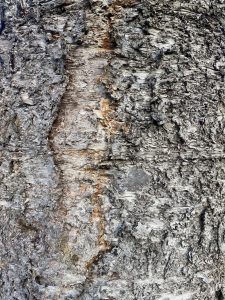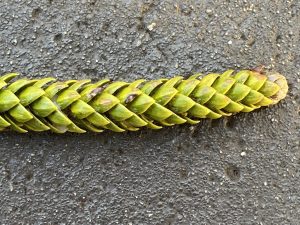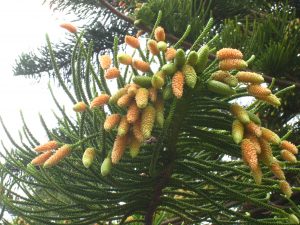Norfolk Island & Cook Pines
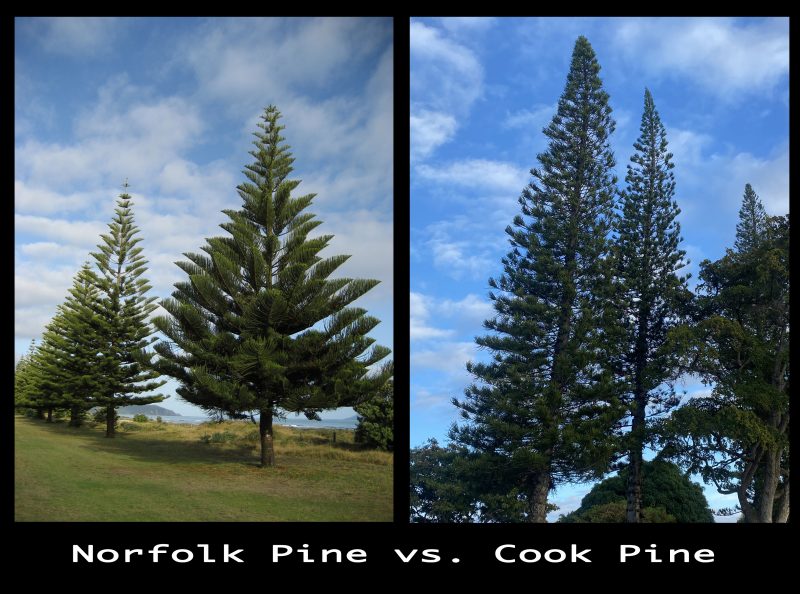
Norfolk Island Pines and Cook Pines are hard to tell apart as they are closely related species. Both species also change characteristics considerably from infancy to adulthood making identification harder. Cook Pines were extensively used to reforest the foothills and ridges of O’ahu in the early 20th century, but these trees were quickly given the misleading nickname “Norfolk Island Pines” by locals. The confusion is thus at least a century old. Perform an online search for images of Norfolk Pines and many of the images are clearly Cook Pines. When young, the two trees are so similar it can be even harder or impossible to tell them apart.
Norfolk Island Pine
An evergreen conifer, native to Norfolk Island, a small island (about 4 by 5 miles) in the southern Pacific Ocean between New Zealand and New Caledonia. Norfolk Island was abandoned by its original Polynesian settles, later became a British penal colony, then was used to resettle the descendants of the Bounty mutineers from Pitcairn Island. The Norfolk Island pine was discovered on the second expedition of Capt. James Cook (1772–75). The island’s association with the tree is strong as evidenced by the flag. Despite its common name, the tree is not a true pine. Wood used for knotty pine paneling, turned bowls, and bracelets.
Hawaii is a leading supplier of “Norfolk Island Pine” seed to other parts of the world. The seed supplied is Cook rather than Norfolk Pine, although possibly a little may be hybridized. Hybridization is unlikely because the two species shed pollen 6 months apart. Seed and foliage samples sent to Kew Gardens were all identified as Cook.
Cook Pine
The tree is endemic to New Caledonia in the Melanesia region of the Pacific, particularly found on Isle of Pines, some 25 miles southeast of the main island of Grande Terre. The tree was first classified by Johann Reinhold Forster, a botanist on the second voyage of Captain James Cook to circumnavigate the globe as far south as possible. It is named directly for Captain Cook, and not for the Cook Islands. Cook never disembarked on the island. In an eerie parallel with Norfolk island, this island became a French penal colony in 1872.
Unique among all trees in the world is that it leans towards the equator. The entire tree leans, from the base to the crown, and the lean is greater with increasing latitude. The reason for the lean is not well understood. Since leaning commonly leads to falling over, this may be an example of a deleterious gene that has not been removed from the population because the native range of the species is near the equator, where the lean is generally not apparent. Hawaii is close enough to the equator to make the lean almost imperceptible.
In the 1920s territorial forester Judd liked to send his men up the Ko’olau ridges with one hundred Cook seeds to plant at intervals on the way to the summit. Some of those trees have survived to this to day, for example on the Mau’umae and Wiliwilinui ridges.
The Cook pine was planted extensively in Christmas tree plantations and was exported to the West Coast as a novelty Christmas tree.
A Comparison
| Norfolk Island Pine | Cook Pine | |
| Scientific name | Araucaria heterophylla (heterophylla is a reference to varying leaf shape) | Araucaria columnaris |
| Other names | Australian Pine
Araukaria Star Pine |
Araucaria cookii
Coral reef araucaria New Caledonia pine Cook araucaria Columnar araucaria |
| Tree Shape | Conical, up to 210 ft high in favorable conditions
Straight vertical trunk up to 5 ft in diameter Symmetrical branches |
Columnar in adulthood (narrowly conical), up to 200 ft tall, in Hawai’i up to 140 ft.
Straight upright trunk, up to 3 ft in diameter Young trees look like Norfolk Pines. Branches short and spreading in a plane. |
| Bark | Gray-brown, in juveniles smooth, in adults rough, exfoliating in fine scales, flaking | gray, papery, exfoliating in thin strips |
| Whorl (floor) | Whorls in 4-7 branches (typically 5 in perfect pentagon) | Branches horizontal or slightly drooping
Whorls in 6-9 branches (typically 8) |
| Leaves | Young leaves: light green, soft, awl-shaped (linear and tapering to sharp point), incurved, ½” long, not overlapping
On mature trees: dark green, arranged in branchlets, scale-like and overlapping, ¼” long |
Young leaves: narrow, awl-shaped, up to ½” long, 1/8” wide
Older branches: leaves arranged in branchlets 3/8” thick, broadly triangular scales, up to ¼” long, 1/6” wide, closely overlapping and curving inward, like a rope, in spiral arrangement. |
| Seed cones | Usually, female and male cones are on separate trees.
Female cone broader than long, erect, 4-5” tall, with triangular scales Male cone in clusters, elongated, 1 ½” long, yellowish-brown or reddish |
Usually, female and male cones are on separate trees.
Female cones (4-5″ long, 3” wide) are upright, scaly, egg-shaped and located in the upper branches. Male cones (2-3″ long, ¾” wide) are drooping, scaly, cylindrical and hang from the lower branches, at tip of branchlets. |
| Seeds | About 1” long, less than ½” wide with wide wings, with swollen body to 3/8” inch thick, edible. | About 1 ½” long, wings broadly rounded |
| Seedling | four broad cotyledons 1/8–3/16“ wide | four narrow cotyledons about 1/16” wide |
Terms
- Cotyledon – an embryonic leaf in seed-bearing plants, one or more of which are the first leaves to appear from a germinating seed.
- Whorl – a circular arrangement of three or more plant parts that radiate from a single point and wrap around the stem or stalk.
Sources
- Native Paths to Volunteer Trails, Stuart Ball
- Worldwide hemisphere-dependent lean in Cook pines. Ecology. 98 (9), Johns, J. W. et al.
- World Flora Online https://worldfloraonline.org/
- Common Forest Trees of Hawaii (Native and Introduced) by Elbert L. Little Jr. and Roger G. Skolmen
- The Gymnosperm Database https://www.conifers.org/
If you are interested in cutting your own Hawaiian Christmas Tree, The Department of Land and Natural Resources Division of Forestry and Wildlife Forestry Program grants collection permits. This is a wonderful opportunity to celebrate the holidays Hawaiian style. Click the link below to apply for your collection permit, there is a $10 fee per tree. https://dlnr.hawaii.gov/forestry/frs/permitting/forest-reserve-system-collection-permit/
Images
Click on image to enlarge view.


